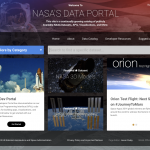 One of the more interesting trends of the last few years has been the opening up of vast swathes of data for innovators to start hacking away and trying to come up with creative solutions.
One of the more interesting trends of the last few years has been the opening up of vast swathes of data for innovators to start hacking away and trying to come up with creative solutions.
The latest organization to go down this route is the US space agency NASA, who have opened a new open data portal.
At the moment there are around 10,000 data sets available on the portal, each of which has its own API to help people make use of it.
“We have a new Open Innovation team to continue NASA’s efforts to meet the White House mandate to set our data free – in a format that is useful for you. In doing so, we hope to spark your creative juices and equip you with tools to innovate your world – whether local, global, or interstellar – leveraging our digital assets. We may not be able to offer you the ride-of-your-life on a spaceship (at least for now), but we can certainly work together to solve looming challenges here on Earth – using NASA data, tools, and resources,” NASA say.
The data includes that from missions across the solar system all the way down to the most granular locations on earth.
It’s a great example of the potential from being more open with the data we hold. We’re better able to collect data than ever before, so the challenge then becomes how to make better use of it, both for ourselves and for society.
Hopefully the NASA Data Portal will be another step down the road towards achieving that, giving us a much better understanding of the world around us.
For instance, it’s estimated that under one percent of all images taken by satellites are ever even looked at. Opening up this data allows much greater manpower to be deployed to that effect.
It’s an approach that astronaut Ron Garan is fully on board with. Check out his fascinating talk below on the importance of information transparency and openness.
That is pretty exciting. I must say though, I was very shocked to hear that so few satellite images were actually looked at. I mean they must cost a fortune to produce.